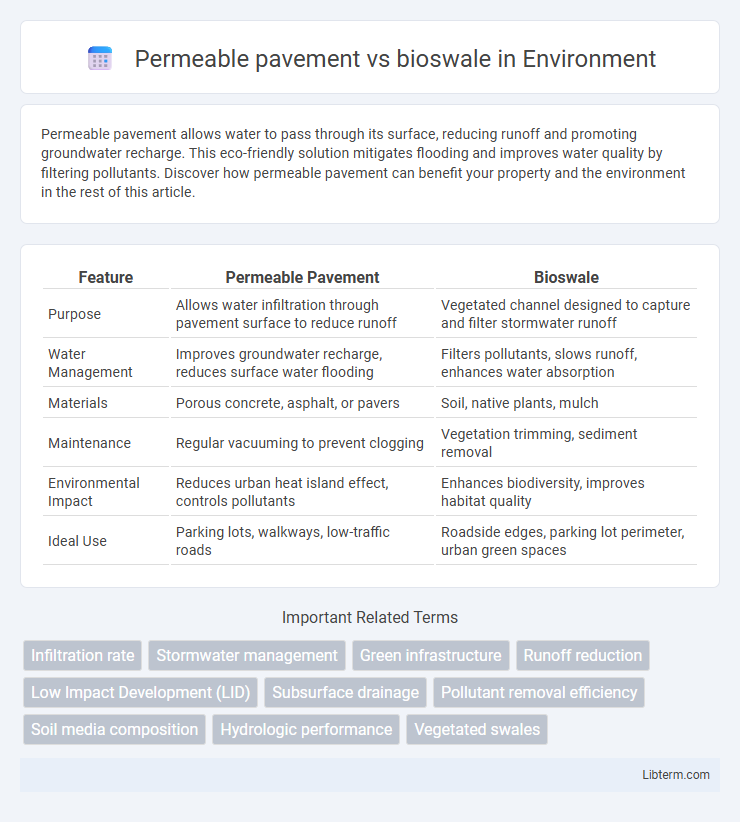Permeable pavement allows water to pass through its surface, reducing runoff and promoting groundwater recharge. This eco-friendly solution mitigates flooding and improves water quality by filtering pollutants. Discover how permeable pavement can benefit your property and the environment in the rest of this article.
Table of Comparison
| Feature | Permeable Pavement | Bioswale |
|---|---|---|
| Purpose | Allows water infiltration through pavement surface to reduce runoff | Vegetated channel designed to capture and filter stormwater runoff |
| Water Management | Improves groundwater recharge, reduces surface water flooding | Filters pollutants, slows runoff, enhances water absorption |
| Materials | Porous concrete, asphalt, or pavers | Soil, native plants, mulch |
| Maintenance | Regular vacuuming to prevent clogging | Vegetation trimming, sediment removal |
| Environmental Impact | Reduces urban heat island effect, controls pollutants | Enhances biodiversity, improves habitat quality |
| Ideal Use | Parking lots, walkways, low-traffic roads | Roadside edges, parking lot perimeter, urban green spaces |
Understanding Permeable Pavement
Permeable pavement is a sustainable urban drainage solution that allows water to infiltrate through its surface, reducing runoff and promoting groundwater recharge. Constructed from porous materials such as pervious concrete, porous asphalt, or permeable interlocking pavers, it effectively filters pollutants and minimizes stormwater volume. Compared to bioswales, permeable pavements integrate seamlessly into paved areas, offering structural support while enhancing water management in urban environments.
What Is a Bioswale?
A bioswale is a landscape element designed to concentrate and convey stormwater runoff while removing debris and pollution through natural processes. Unlike permeable pavement, which allows water to infiltrate directly through the surface material, a bioswale uses vegetation and soil filtration to enhance water quality and manage runoff. Bioswales are especially effective in urban environments for reducing surface water pollution and promoting groundwater recharge.
Key Differences Between Permeable Pavement and Bioswales
Permeable pavement allows water to infiltrate through its surface, reducing runoff and improving groundwater recharge, while bioswales use vegetation and soil to filter pollutants from stormwater and direct it towards infiltration areas. Unlike bioswales, permeable pavements are typically installed on driveways, parking lots, and walkways, offering structural support alongside water management. Bioswales emphasize ecological benefits by enhancing habitat and biodiversity, whereas permeable pavement focuses on reducing surface water accumulation and urban heat island effects.
Stormwater Management Efficiency
Permeable pavement enhances stormwater management efficiency by allowing water to infiltrate through surfaces, reducing runoff and replenishing groundwater. Bioswales filter stormwater through vegetation and soil, effectively removing pollutants and slowing water flow to prevent flooding. Combining permeable pavement with bioswales maximizes infiltration and filtration, improving overall stormwater control in urban environments.
Installation and Maintenance Requirements
Permeable pavement requires precise grading and sub-base preparation to ensure proper water infiltration and structural support, often involving higher initial labor and material costs compared to bioswales. Bioswales demand careful selection of native vegetation and regular maintenance such as weeding and sediment removal to sustain their water filtration and flow capacity. While permeable pavement necessitates routine vacuuming to prevent clogging, bioswales depend on seasonal plant care and occasional soil amendment for optimal performance.
Environmental Benefits Comparison
Permeable pavement reduces stormwater runoff by allowing water to infiltrate through its porous surface, decreasing urban flooding and improving groundwater recharge. Bioswales filter pollutants through vegetation and soil, enhancing water quality and supporting biodiversity in urban landscapes. Both systems mitigate erosion and reduce the burden on sewer systems, but bioswales provide greater habitat value while permeable pavements offer durable infrastructure solutions.
Cost Analysis: Permeable Pavement vs Bioswale
Permeable pavement installation typically incurs higher upfront costs, ranging between $5 to $15 per square foot, compared to bioswales which generally cost $3 to $7 per square foot, depending on soil and vegetation types. Maintenance expenses for permeable pavement include regular vacuuming and pressure washing, averaging $0.10 to $0.20 per square foot annually, while bioswales require seasonal vegetation management and sediment removal, costing around $0.05 to $0.15 per square foot per year. Long-term cost benefits arise from permeable pavement's durability and stormwater infiltration efficiency, whereas bioswales offer ecological advantages and can reduce municipal drainage costs through natural filtration.
Urban Design and Aesthetic Considerations
Permeable pavement enhances urban design by integrating functional ground surfaces that reduce stormwater runoff while maintaining smooth pedestrian and vehicular access, offering a modern, clean aesthetic with customizable textures and colors. Bioswales contribute a natural, green element, promoting biodiversity and visual softness with their planted vegetation that filters water and enriches streetscapes, ideal for areas prioritizing ecological benefits and greenery. Combining both strategies in urban environments improves stormwater management and creates visually appealing, sustainable public spaces that balance infrastructure needs with aesthetic considerations.
Choosing the Right Solution for Your Project
Permeable pavement and bioswales both serve vital roles in stormwater management, but selecting the right solution depends on site conditions and project goals. Permeable pavement is ideal for areas requiring durable surfaces that allow water infiltration, such as parking lots and walkways, effectively reducing runoff and improving groundwater recharge. Bioswales are best suited for landscaped zones needing pollutant filtration and water conveyance, providing natural habitat benefits and enhanced water quality.
Future Trends in Green Infrastructure
Permeable pavement and bioswales are pivotal components in the future of green infrastructure, addressing urban stormwater management through natural filtration and groundwater recharge. Advances in permeable pavement technology focus on enhanced durability and pollutant capture, while bioswales are being integrated with smart sensors for real-time water quality monitoring. Emerging trends emphasize combining these solutions with digital tools and climate-responsive designs to create resilient urban landscapes that mitigate flooding and improve ecosystem health.
Permeable pavement Infographic

 libterm.com
libterm.com